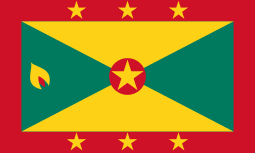Caribbean cuisine
Caribbean cuisine is a fusion of African,[1] Creole, Cajun, Amerindian, European,[1] Portuguese, Spanish/Latin American, East Indian/South Asian, Arab, Chinese, Jewish, and Javanese/Indonesian cuisine. These traditions were brought from many different countries when they came to the Caribbean.[1] In addition, the population has created styles that are unique to the region.
Caribbean dishes
Ingredients that are common in most islands' dishes are rice, plantains, beans, cassava, cilantro (coriander), bell peppers, chickpeas, tomatoes, sweet potatoes, coconut, and any of various meats that are locally available like beef, poultry, pork or fish. A characteristic seasoning for the region is a green herb and oil based marinade which imparts a flavor profile which is quintessentially Caribbean in character. Ingredients may include garlic, onions, scotch bonnet peppers, celery, green onions, and herbs like cilantro, marjoram, rosemary, tarragon and thyme. This green seasoning is used for a variety of dishes like curries, stews and roasted meats.[2]
Traditional dishes are so important to regional culture that, for example, the local version of Caribbean goat stew has been chosen as the official national dish of Montserrat and is also one of the signature dishes of St. Kitts and Nevis. Another popular dish in the Anglophone Caribbean is called "Cook-up", or pelau. Ackee and saltfish is another popular dish that is unique to Jamaica. Callaloo is a dish containing leafy vegetables and sometimes okra amongst others, widely distributed in the Caribbean, with a distinctively mixed African and indigenous character.
The variety of dessert dishes in the area also reflects the mixed origins of the recipes. In some areas, Black Cake, a derivative of English Christmas pudding may be served, especially on special occasions.
Over time, food from the Caribbean has evolved into a narrative technique through which their culture has been accentuated and promoted. However, by studying Caribbean culture through a literary lens there then runs the risk of generalizing exoticist ideas about food practices from the tropical. Some food theorists argue that this depiction of Caribbean food in various forms of media contributes to the inaccurate conceptions revolving around their culinary practices, which are much more grounded in unpleasant historical events. Therefore, it can be argued that the connection between the idea of the Caribbean being the ultimate paradise and Caribbean food being exotic is based on inaccurate information.[3]
By location
-
 Anguillian cuisine
Anguillian cuisine -
 Antigua and Barbuda cuisine
Antigua and Barbuda cuisine -
 Barbadian Cuisine
Barbadian Cuisine -
 Bahamian cuisine
Bahamian cuisine -
 Belizean cuisine
Belizean cuisine -
 Cayman Islands cuisine
Cayman Islands cuisine -
 Colombian cuisine
Colombian cuisine -
 Costa Rican cuisine
Costa Rican cuisine -
 Cuban cuisine
Cuban cuisine -
 Curaçaoan cuisine
Curaçaoan cuisine -
 Dominica cuisine
Dominica cuisine -
 Dominican Republic cuisine
Dominican Republic cuisine -
 Salvadoran cuisine
Salvadoran cuisine -
 French Guianese Cuisine
French Guianese Cuisine -
 Grenadan cuisine
Grenadan cuisine -
 Guatemalan cuisine
Guatemalan cuisine -
 Haitian cuisine
Haitian cuisine -
 Honduran cuisine
Honduran cuisine -
 Jamaican cuisine
Jamaican cuisine -
 Mexican cuisine
Mexican cuisine -
 Nicaraguan cuisine
Nicaraguan cuisine -
 Puerto Rican cuisine
Puerto Rican cuisine  Panamanian cuisine
Panamanian cuisine Saint Kitts and Nevis cuisine
Saint Kitts and Nevis cuisine-
 Trinidadian and Tobagonian cuisine
Trinidadian and Tobagonian cuisine -
 British Virgin Islands cuisine
British Virgin Islands cuisine -
 United States Virgin Islands cuisine
United States Virgin Islands cuisine -
 Venezuelan cuisine
Venezuelan cuisine
See also
| Wikibooks Cookbook has a recipe/module on |
References
- 1 2 3 "Cuisine." (Caribbean.) Bahamabreeze.com. Accessed July 2011.
- ↑ Caribbean Green Seasoning Recipe
- ↑ Graziadei, Daniel. “The Fierce Questioning of Fictional Caribbean Commnion in Édouard Glissant’s Ormerod and Fortuné Chalumeau’s Désirade, ô Serpente!” In Caribbean Food Cultures: Culinary Practices and Consumption in the Caribbean and Its Diasporas, edited by Wiebke Beuhausen, Anne Brüske, Ana-Sofia Commichau, Patrick Helber, and Sinah Kloß, 89-96.